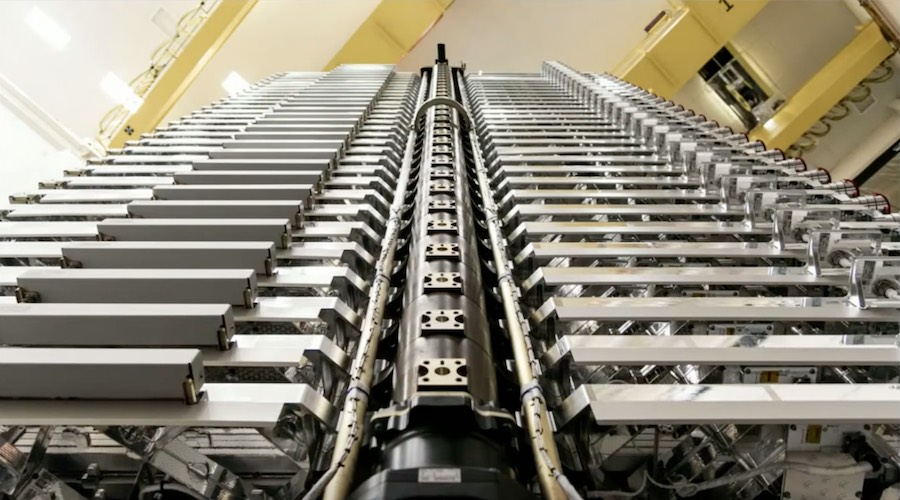
SpaceX plans to kick off its 2022 launch schedule with a Falcon 9 rocket flight Thursday from NASA’s Kennedy Space Center with the company’s next group of Starlink internet satellites.
In a change from previous Starlink missions, the Falcon 9 rocket will fly southeast from the coast of Florida on a course just north of the Bahamas to place the new batch of internet satellites into low Earth orbit a few hundred miles above Earth.
The mission, designated Starlink 4-5, is expected to target an orbital plane with a tilt of 53.2 degrees to the equator, one of five orbital “shells” at different inclination angles that SpaceX plans to fill with around 4,400 satellites to provide high-speed, low-latency broadband connectivity around the world.
SpaceX’s previous launches carrying Starlink satellites to a similar orbit have flown northeast from Florida’s Space Coast. Launches to the southeast must fly around the Bahamas to avoid the risk of dropping debris on populated islands.
Maritime warning notices suggest the mission scheduled for Thursday will do just that, tracking over the Atlantic Ocean north of the Abaco Islands, before making a slight right turn to head farther downrange.
SpaceX plans to land the Falcon 9’s first stage booster on the drone ship “A Shortfall of Gravitas” positioned in the Atlantic. The landing platform departed Port Canaveral Saturday to head for the recovery zone.
The launch Thursday is targeted for 4:49 p.m. EST (2149 GMT), with a backup time available at 6:47 p.m. EST (2347 GMT).
Meanwhile, crews at nearby Cape Canaveral Space Force Station are preparing another Falcon 9 rocket for liftoff no earlier than Jan. 13 with dozens of small satellites from U.S. and international customers. That mission, known as Transporter 3, is SpaceX’s third dedicated rideshare launch hauling smallsats into a sun-synchronous orbit.
Liftoff time Jan. 13 is set for 10:25 a.m. EST (1525 GMT), and SpaceX is expected to land the first stage on an onshore pad at Cape Canaveral.

The mission set for Thursday will mark SpaceX’s 34th dedicated launch with Starlink satellites. SpaceX hasn’t said why the Falcon 9 rocket will take the southeasterly route to orbit on the next flight, or disclosed how many Starlink satellites will be on-board.
Dedicated Falcon 9 launches with SpaceX’s latest generation of Starlink spacecraft have carried between 48 and 53 satellites per mission. SpaceX has launched 1,944 Starlink satellites to date, and the next mission will nudge that sum close to 2,000.
But not all of those satellites remain in orbit. Some have failed after launch, and SpaceX has intentionally de-orbited others, either due to technical problems or obsolescence as newer designs reach orbit.
A tabulation by Jonathan McDowell, an astrophysicist and expert tracker of spaceflight activity, shows SpaceX has 1,468 satellites providing Starlink internet service as of Sunday.
The flat-panel satellites are each a little more than a quarter-ton. After separation from the Falcon 9 rocket, the satellites will use krypton-fueled ion thrusters to maneuver into their operating orbits at an altitude of 335 miles (540 kilometers), joining the rest of the Starlink fleet.
SpaceX has a long-term plan to launch as many as 42,000 Starlink satellites, according to a company filing with the International Telecommunication Union. The company’s initial focus is on deploying around 4,400 satellites into the first five orbital shells.
Jonathan Hofeller, SpaceX’s vice president of Starlink and commercial sales, said last month that the Starlink network is providing internet service to consumers in more than 20 countries.
“We have well over 100,000 subscribers, both on the consumer and enterprise sides,” he said in a panel discussion at Euroconsult’s annual World Satellite Business Week event in Paris. “And we’re not slowing down. We’re just getting warmed up.”
SpaceX hopes to use revenue from the Starlink business unit to help fund the company’s ambitions to complete development of the heavy-lift Starship rocket, a massive fully reusable launcher designed to eventually replace the Falcon 9 and Falcon Heavy rockets.
Email the author.
Follow Stephen Clark on Twitter: @StephenClark1.
from Spaceflight Now https://ift.tt/31hNi9t
via World Space Info







0 comments:
Post a Comment